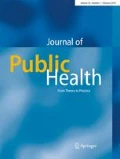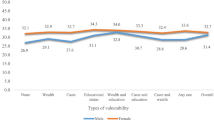Abstract
Background
Although individuals with frailty and lower socioeconomic status (SES) are vulnerable to morbidity and early mortality, few studies have investigated this association. We intend to fill this gap with a study using older adults aged ≥ 50 years from the SAGE WAVE I 2007 in India.
Objective
The two objectives of the study are to examine the association of frailty with SES and how this association varies across different age groups.
Methods
A modified Fried phenotype approach with five frailty indicators was used to categorize 6560 older adults as frail, pre-frail or robust who had more than two, one or zero indicators, respectively: grip strength, exhaustion, weight loss, walking speed and physical activity. Multinomial logistic regression estimated the likelihood of being pre-frail and frail for various levels of SES, controlling and not controlling for confounders. This study also shows the overall socioeconomic gradients and age patterns of socioeconomic gradients of frailty indicators using predicted probabilities.
Results
Approximately 26%, 55% and 20% participants were robust, pre-frail and frail, respectively. The number of frailty indicators was positively associated with lower income and education levels in the case of controlling and not controlling for confounders. Also, among the higher age groups, individuals with low SES had higher chances of being frail.
Conclusion
Overall, the results in this article indicated a negative low SES and frailty association as found in previous studies worldwide. This highlights the need for comprehensive and centered public health interventions for older adults with low SES.




Similar content being viewed by others
References
Adler NE, Newman K (2002) Socioeconomic disparities in health: pathways and policies. Health Aff 21(2):60–76
Balia S, Jones AM (2008) Mortality, lifestyle and socio-economic status. J Health Econ 27(1):1–26
Blaum CS, Xue QL, Michelon E, Semba RD, Fried LP (2005) The association between obesity and the frailty syndrome in older women: the Women's Health and Aging Studies. J Am Geriatr Soc 53(6):927–934
Bull FC, Maslin TS, Armstrong T (2009) Global physical activity questionnaire (GPAQ): nine country reliability and validity study. J Phys Act Health 6(6):790–804
Chen E, Miller GE (2013) Socioeconomic status and health: mediating and moderating factors. Annu Rev Clin Psychol 9:723–749
Ensrud KE, Ewing SK, Taylor BC, Fink HA, Cawthon PM, Stone KL et al (2008) Comparison of 2 frailty indexes for prediction of falls, disability, fractures, and death in older women. Arch Intern Med 168(4):382–389
Ferguson BD, Tandon A, Gakidou E, Murray CJ (2003) Estimating permanent income using indicator variables. Health systems performance assessment: debates, methods and empiricism. World Health Organization, Geneva, pp 747–760
Fried LP, Tangen CM, Walston J, Newman AB, Hirsch C, Gottdiener J et al (2001) Frailty in older adults evidence for a phenotype. J Gerontol Ser A Biol Med Sci 56(3):M146–M157
Fugate Woods N, LaCroix AZ, Gray SL, Aragaki A, Cochrane BB, Brunner RL et al (2005) Frailty: emergence and consequences in women aged 65 and older in the Women's Health Initiative Observational Study. J Am Geriatr Soc 53(8):1321–1330
Gallo LC, Matthews KA (2003) Understanding the association between socioeconomic status and physical health: do negative emotions play a role? Psychol Bull 129(1):10
Garre-Olmo J, Calvó-Perxas L, López-Pousa S, de Gracia Blanco M, Vilalta-Franch J (2013) Prevalence of frailty phenotypes and risk of mortality in a community-dwelling elderly cohort. Age Ageing 42(1):46–51
Guessous I, Luthi JC, Bowling CB, Theler JM, Paccaud F, Gaspoz JM, & McClellan W. (2014). Prevalence of frailty indicators and association with socioeconomic status in middle-aged and older adults in a Swiss region with universal health insurance coverage: a population-based cross-sectional study. Journal of aging research, 2014. Hermalin (Ed.), The well-being of the elderly in Asia (pp. 362–412). Ann Arbor: University of Michigan Press
Hirsch C, Anderson ML, Newman A, Kop W, Jackson S, Gottdiener J et al (2006) The association of race with frailty: the cardiovascular health study. Ann Epidemiol 16(7):545–553
Hogan DB. (2003). Models, Definitions, and Criteria of Frailty-50
House JS, Lantz PM, Herd P (2005) Continuity and change in the social stratification of aging and health over the life course: evidence from a nationally representative longitudinal study from 1986 to 2001/2002 (Americans' Changing Lives Study). J Gerontol B Psychol Sci Soc Sci 60(Special_Issue_2):S15–S26
Hurt LS, Ronsmans C, Saha S (2004) Effects of education and other socioeconomic factors on middle age mortality in rural Bangladesh. J Epidemiol Community Health 58(4):315–320
Kitagawa E, Hauser P (1973) Differential mortality in the United States: A study in socioeconomic epidemiology. Harvard University Press, Cambridge
Kowal P, Chatterji S, Naidoo N, Biritwum R, Fan W, Lopez Ridaura R et al (2012) Data resource profile: the World Health Organization Study on global AGEing and adult health (SAGE). Int J Epidemiol 41(6):1639–1649
Lantz PM, House JS, Lepkowski JM, Williams DR, Mero RP, Chen J (1998) Socioeconomic factors, health behaviors, and mortality: results from a nationally representative prospective study of US adults. JAMA 279(21):1703–1708
Liang J, McCarthy JF, Jain A, Krause N, Bennett JM, Gu S (2000) Socioeconomic gradient in old age mortality in Wuhan, China. The Journals of Gerontology. Series B, Psychological Sciences and Social Sciences 55(4):S222–S233
Lorant V, Deliège D, Eaton W, Robert A, Philippot P, Ansseau M (2003) Socioeconomic inequalities in depression: a meta-analysis. Am J Epidemiol 157(2):98–112
Marmot MG, Shipley MJ, Rose G (1984) Inequalities in death–specific explanations of a general pattern? Lancet 1(8384):1003–1006
McDonough P, Duncan GJ, Williams D, House J (1997) Income dynamics and adult mortality in the United States, 1972 through 1989. Am J Public Health 87(9):1476–1483
Mirowsky J, Ross CE (2008) Education and self-rated health: cumulative advantage and its rising importance. Research on Aging 30(1):93–122
Morenoff JD, Lynch, JW (2004) What makes a place healthy? Neighborhood influences on racial/ethnic disparities in health over the life course. In: Norman B. Anderson, Randy A. Bulatao, and Barney Cohen (eds) Critical perspectives on racial and ethnic differences in health in late life. National Academy Press, Washington
Newman AB, Gottdiener JS, McBurnie MA, Hirsch CH, Kop WJ, Tracy R et al (2001) Associations of subclinical cardiovascular disease with frailty. J Gerontol Ser A Biol Med Sci 56(3):M158–M166
Ostrove JM, Feldman P, Adler NE (1999) Relations among socioeconomic status indicators and health for African-Americans and Whites. J Health Psychol 4(4):451–463
Pampel FC, Krueger PM, Denney JT (2010) Socioeconomic disparities in health behaviors. Annu Rev Sociol 36:349–370
Pollitt RA, Kaufman JS, Rose KM, Diez-Roux AV, Zeng D, Heiss G (2007) Early-life and adult socioeconomic status and inflammatory risk markers in adulthood. Eur J Epidemiol 22(1):55–66
Rodríguez-Mañas L, Féart C, Mann G, Viña J, Chatterji S, Chodzko-Zajko W et al (2013) Searching for an operational definition of frailty: a Delphi method based consensus statement. The frailty operative definition-consensus conference project. J Gerontol Ser A Biol Med Sci 68(1):62–67
Rosero-Bixby L, Dow WH (2009) Surprising SES Gradients in mortality, health, and biomarkers in a Latin American population of adults. Journals of Gerontology. Series B, Psychological Sciences and Social Sciences 64(1):105–117
Smith KV, Goldman N (2007) Socioeconomic differences in health among older adults in Mexico. Soc Sci Med 65(7):1372–1385
Singh‐Manoux A, Marmot MG, Glymour M, Sabia S, Kivimäki M, Dugravot A (2011) Does cognitive reserve shape cognitive decline? Ann Neurol 70(2):296–304
Steptoe A, Feldman PJ, Kunz S, Owen N, Willemsen G, Marmot M (2002) Stress responsivity and socioeconomic status. A mechanism for increased cardiovascular disease risk? Eur Heart J 23(22):1757–1763
Sternberg SA, Wershof Schwartz A, Karunananthan S, Bergman H, Mark CA (2011) The identification of frailty: a systematic literature review. J Am Geriatr Soc 59:2129–2138
Taylor SE, Repetti RL, Seeman T (1997) Health psychology: what is an unhealthy environment and how does it get under the skin? Annu Rev Psychol 48(1):411–447
van Kan GA, Rolland Y, Houles M, Gillette-Guyonnet S, Soto M, Vellas B (2010) The assessment of frailty in older adults. Clin Geriatr Med 26(2):275–286
Wandera SO, Kwagala B, Ntozi J (2015) Determinants of access to healthcare by older persons in Uganda: a cross-sectional study. Int J Equity Health 14(1):26
Woo J, Goggins W, Sham A, Ho SC (2005) Social determinants of frailty. Gerontology 51(6):402–408
Zimmer Z, Amornsirisomboon P (2001) Socioeconomic status and health among older adults in Thailand: an examination using multiple indicators. Soc Sci Med 52(8):1297–1311
Zimmer Z, Kwong J (2004) Socioeconomic status and health among older adults in rural and urban China. Journal of Aging and Health 16(1):44–70
Zimmer Z, Chayovan N, Lin HS, Natividad J (2004) How indicators of socioeconomic status relate to physical functioning of older adults in three Asian societies. Research on Aging 26(2):224–258
Zimmer Z, Natividad JN, Ofstedal MB, & Lin H. (2002). Physical and mental health of the elderly. In A. I
Author information
Authors and Affiliations
Corresponding author
Ethics declarations
Conflict of interest
The authors have no conflict of interest.
Informed consent
The study used the data set that is available online in the public domain; hence, there was no need to seek ethical consent to publish this study.
Ethical treatment of experimental subjects (animal and human)
This article does not contain any studies with human or animal subjects performed by the author.
Rights and permissions
About this article
Cite this article
Chaudhary, M., Chowdhary, R. Age and socioeconomic gradients in frailty among older adults in India. J Public Health (Berl.) 27, 675–685 (2019). https://doi.org/10.1007/s10389-018-0988-3
Received:
Accepted:
Published:
Issue Date:
DOI: https://doi.org/10.1007/s10389-018-0988-3




